The Freedom Rings Sculpture
Introduction
Text-to-speech Audio
Dedicated in 2009, this sculpture at the entrance to the Wakarusa River Valley Heritage Museum represents the relationship between the efforts of African Americans to escape slavery and the residents of nearby rural communities. Just as the nearby museum shares the histories of Kanwaka, Stull, Old Belvoir, New Belvoir, Clinton, Bloomington, Twin Mound, Sigel, and Richland, this sculpture reflects one aspect of the area before the Civil War when Kansas reflected the nation's divide over slavery. While communities like Leavenworth and Atchison were home to many proslavery settlers, residents from Lawrence to Topeka typically opposed the extension of slavery. Designed by Stephen Johnson and built by Cotter Mitchell, the sculpture features ten large, yellow rings of varying sizes surrounding a tall windmill. A glass sphere rests at the top of the windmill in the sculpture's center. Together, the sphere and the windmill geographically align with the North Star to symbolize the "beacon of freedom" that many of the Wakarusa River Valley communities represented.
Images
The Freedom Rings Sculpture

Diagram of the Freedom Rings

Stephen Johnson
.jpg)
The original location of the windmill on the Oldfather farm. The windmill was overgrown with trees and vines.
.jpg)
Removal of the windmill from the Oldfather farm.
.jpg)
Transport of the windmill to the Wakarusa Museum grounds.
.jpg)
Transport of the windmill to the Wakarusa Museum grounds.
.jpg)
Transport of the windmill to the Wakarusa Museum grounds.
.jpg)
Backstory and Context
Text-to-speech Audio
The idea for the Freedom Rings sculpture began with the decision to relocate an old windmill, built on the property of Tensie Oldfather, who lived southwest of Lawrence, to the Wakarusa Museum grounds. The land was initially owned by S.M. Shepherd, an abolitionist who supported the Underground Railroad. The windmill was a significant contribution to the Wakarusa Museum, which documents the history of antislavery activity within the Wakarusa River Valley region in the "Angels of Freedom" exhibit.
While the Underground Railroad is often associated with hidden passageways and abolitionists who provided shelter and active defense from would-be enslavers known as "slave catchers," the path from slavery to freedom in places like eastern Kansas depended more on creating and maintaining a population that was hostile to slavery and supportive towards African American families. While some formerly enslaved people created new lives in places like southern Indiana or eastern Kansas, others continued their journey by traveling north along the Underground Railroad to upstate New York or Canada. Residents of this valley, like those in northern communities who actively supported African Americans escaping slavery, defied federal laws that obligated Americans to report runaways and support slave catchers, sometimes by actively supporting runaways, but more often, by inaction and supporting political leaders who defied the will of Southern slaveholders and politicians who represented them.
Upon relocation of the windmill, the Wakarusa Museum sent out a call to local artists, challenging them to create a sculpture around the windmill that represented the history of the region. Several proposals were submitted, and the museum board awarded the artist contract to Stephen Johnson. Johnson designed the sculpture with the "power of the circle" in mind. According to Johnson, the circular shape of the rings are meant to invoke a number of ideas. Perhaps the large hoops symbolize the wagon wheels of Euro-American settlers moving westward to establish the communities of the Wakarusa River Valley. The rings could also represent the difficult journey of escaped slaves moving along the Underground Railroad, guided by the North Star. Furthermore, the rings "celebrate the dynamic circle of families, friends, and community spirit that constitute free communities and a free state."
The Freedom Rings sculpture was completed and dedicated on June 20th, 2009. During the dedication ceremony, the sculpture was commemorated with an outdoor performance by the 940 Dance Company and KU Dance groups. Directed by Susan Rieger and Joan Stone, the interpretive dance performance honored the sculpture's message.
Sources
Johnson, Stephen. "Proposal for the Wakarusa River Valley Heritage Museum Windmill Freedom's Light Sculpture." "Freedom Rings" folder, Museum Documents, The Wakarusa River Valley Heritage Museum.
"Freedom Rings" brochure. "Freedom Rings" folder, Museum Documents, The Wakarusa River Valley Heritage Museum.
Belt, Mike. "Old windmill a windfall for new museum." The Lawrence Journal-World. Aug. 9, 2007.
"Dance of the Rings" flyer. "Freedom Rings" folder, Museum Documents, The Wakarusa River Valley Heritage Museum.
Marin Massa
The Wakarusa River Valley Heritage Museum
Wakarusa River Valley Heritage Museum
Wakarusa River Valley Heritage Museum
Wakarusa River Valley Heritage Museum
Wakarusa River Valley Heritage Museum
Wakarusa River Valley Heritage Museum
Wakarusa River Valley Heritage Museum
